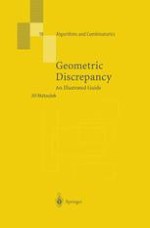1999 | OriginalPaper | Buchkapitel
Lower Bounds
verfasst von : Jiří Matoušek
Erschienen in: Geometric Discrepancy
Verlag: Springer Berlin Heidelberg
Enthalten in: Professional Book Archive
Aktivieren Sie unsere intelligente Suche, um passende Fachinhalte oder Patente zu finden.
Wählen Sie Textabschnitte aus um mit Künstlicher Intelligenz passenden Patente zu finden. powered by
Markieren Sie Textabschnitte, um KI-gestützt weitere passende Inhalte zu finden. powered by
In this chapter, we finally begin with the mathematically most fascinating results in geometric discrepancy theory: the lower bounds (we have already seen some lower bounds in Chapter 4 but not in a geometric setting). So far we have not answered the basic question, Problem 1.1, namely whether the discrepancy for axis-parallel rectangles must grow to infinity as n n → ∞. An answer is given in Section 6.1, where we prove that D(n,R2) is at least of the order $$\sqrt {\log n}$$. Note that, in order to establish a such a result, we have to show that for any n-point set P in the unit square, some axis-parallel rectangle exists with a suitably high discrepancy. So we have to take into account all possible sets P simultaneously, although we have no idea what they can look like. The proof is a two-page gem due to Roth, based on a cleverly constructed system of orthogonal functions on the unit square. In dimension d, the same method gives D(n,R d ) = 52((log n)(d-1)/2)
